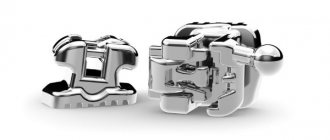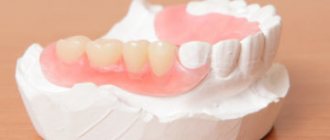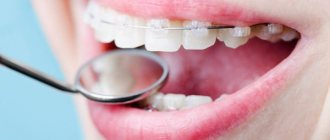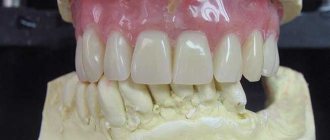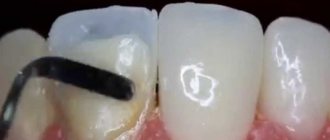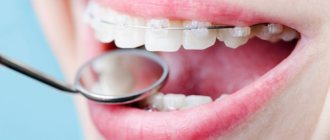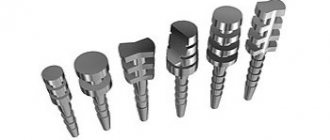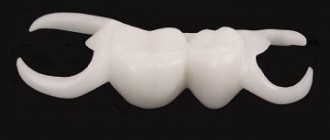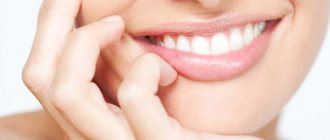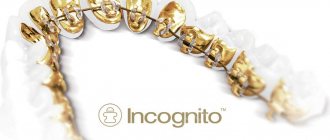Lingual braces are popular orthodontic structures, the use of which makes it possible to eliminate bite defects in a short time and without attracting the attention of others. The effectiveness of the devices is similar to the effectiveness of treating dentition anomalies with traditional devices, and the aesthetics are an order of magnitude higher, since Lingual braces are attached to the inner surface of the teeth.
Fact #2 - The type of wire used for braces was invented by NASA.
One thing you might like is that the wire used for braces was created by none other than NASA!
Dr. Engle's vision was modern, but gold braces were also expensive. The field of orthodontics took a giant leap when NASA developed a metal alloy called nickel-titanium in 1959. While they created this heat-resistant metal for the space shuttle, it is also ideal for making thin, flexible wires that could maintain their shape after being bent and attached to a patient's teeth.
Cost of structures
The cost of lingual braces varies from 50 to 500 thousand rubles. Significant fluctuations in prices are due to the patient’s place of residence (capital, provincial district) and the policy of the management of the clinic providing services.
In addition to these factors, the formation of the final price list is influenced by:
- model of braces used;
- the material they are made of (the most expensive are gold and titanium braces);
- cost of manufacturing, periodic correction, removal.
The average cost of production of 1 system is 65 thousand rubles. After fixing the braces, in addition to 25 thousand for installation, you will have to regularly pay for the work of the orthodontist: each examination will cost 5-6 thousand rubles. Removal of plates is estimated at a minimum of 3 thousand 500 rubles. Estimated prices for retainers are 5–7 thousand rubles.
Lingual braces are expensive designs. But you should not refuse to wear them for this reason, since with their help you can cope with even complex malocclusions.
Fact #3 - Braces are not just for straightening teeth.
While perfectly straight teeth are a wonderful aspect of braces, one of the main benefits is that braces secure the wearer's bite. If your upper front teeth overlap your lower teeth and the ridges of your molars do not touch, you have a perfect bite. Not many people can boast of this.
Braces are more than just cosmetic devices. Because they stabilize your bite, they also provide relief from a variety of health problems, including:
- Breathing problems;
- Problems with chewing and swallowing.
Lingual
Lingual types of braces were developed to increase aesthetics. They are installed on the back of the teeth. Thus, the treatment is absolutely invisible to others.
Important! Lingual braces are preferred by public people whose work constantly involves communication and performances.
In addition to invisibility, the advantages include:
- safety in contact sports;
- can be used by musicians playing wind instruments;
- reducing the risk of caries on the front surface of teeth.
However, there are many more disadvantages:
- high price - you will have to pay from 200 to 400 thousand rubles;
- cannot be installed on children under 12 years of age;
- difficult addiction;
- tongue injury;
- long correction period – up to 2 times longer than with vestibular devices;
- problems with diction often occur;
- complicated hygiene.
Lingual braces often cause problems with diction.
There are 3 types of lingual braces:
- Stb. The fastening mechanism is made using a ligature. Made from an alloy of nickel and cobalt. The thickness of the brackets is 1.5 mm, length is 4.57 mm. Contraindicated for use in cases of severe crowding, too narrow jaws, problems with the temporomandibular joint, or low crown height. The cost varies from 190 to 230 thousand rubles.
- In- Ovation- L. Fixation is carried out with locks. Braces are suitable for patients who need to move their teeth up to 6mm. The price starts from 250 thousand rubles.
- Incognito. The most popular German model. Ligature system, which, unlike others, is carried out individually using CAD/CAM technology based on casts in Germany. The main difficulty is connected with this: if part of the structure breaks, you will have to wait a long time for a replacement, which will complicate treatment. Incognito is made from gold-containing alloys. Price – 300-400 thousand rubles
Additional Information! Monthly correction of Incognito will cost almost 3 times more than servicing other devices - 7,000 versus 2,500.
Fact #4 - Smile like the Egyptians
The desire for straight teeth can be traced back even further than the 18th century in France, all the way to Ancient Egypt! Who knows whether the ancient Egyptians were aware of the health benefits given in the previous fact, or whether they simply wanted straight teeth for cosmetic reasons, but some mummies have indeed been found with temporary "braces." Archaeologists believe that animal intestines wrapped around the mummies' teeth, similar to modern braces, were an attempt to straighten crooked teeth.
Types by fastening method
Invisible braces are much more expensive than traditional braces.
The main difference between braces in terms of the method of fixation is the presence of an arch or locking fasteners. Based on this parameter, lingature and non-ligature systems are distinguished.
Ligature
The arch is secured to the brackets with rubber bands or thin orthodontic wire. This increases the friction force and makes hygiene difficult, but it allows:
- replace the arc at any time without any problems;
- reduce the cost of correction - the price starts from 40 thousand rubles for both jaws;
- increase the reliability of the device.
Ligature structures are visible on the teeth. However, if desired, the fastenings can be painted in a color chosen by the patient.
Unligated
The second name for non-ligating systems is self-ligating. The arc in them is secured with special locks on the brackets. Manufacturers claim that they:
- shorten the duration of orthodontic therapy;
- reduce friction force;
- reduce the number of visits to once every 2 months;
- simplify oral care.
Important! A significant disadvantage of self-ligating braces is the problem of replacing the arch. During the correction, the orthodontist needs to change it several times. Difficulties with manipulation can complicate, reduce the effectiveness of treatment, and distort the final result.
The cost is also high - from 100 thousand rubles.
Fact No. 7 - braces are not only for teenagers, but also for adults
Braces are only for children and teenagers, of course, this was a stereotype of the past. The American Association of Orthodontics reported that approximately one in five orthodontic patients are adults. These days, parents, grandparents and even great-grandparents are determined to reap the benefits of a healthy bite and a straighter smile. It's never too late!
Read also: Number of teeth in children by age
But you should know that the most effective treatment with braces occurs in children. The sooner you take your child for his first orodontist consultation, the sooner you will know what he may need. The American Association of Orthodontics recommends that your child be seen by an orthodontist by age seven. Some incorrect inclusions are best corrected young; in fact, sometimes timely orthodontic care for a small child can completely solve the problem of malocclusion and the child will not have to wear braces!
Fact #8 - You need to bust some myths!
Sometimes myths prevent us from making the right decision and putting on braces. Destroy the myths that prevent you from taking a step towards a beautiful smile?
- You will be able to engage in any sport without restrictions;
- You will be able to play musical instruments effectively, including those that use your mouth;
- Staples do not beep in metal detectors;
- The brackets do not interfere with radio signals;
- The brackets are not magnetic;
- It is impossible to “lock” braces by kissing another person with braces!
Ugh! Nobody wants to have problems with airport security, give up a hobby or kissing. Good news!
Fact #9 - the wonders of time and pressure
Time and pressure work together to create the perfect smile! If you've ever wondered why you have to wear braces for a long time, you'll find this fact especially interesting.
Each tooth has a nerve ending inside it known as cellulose. If your teeth were to realign too quickly, the process would cut off the blood supply. Instead, we adjust your teeth with slow, steady pressure so that the pulp continues to move with the tooth, providing the dental tissue with the blood and nutrition it needs. Braces armatures are designed to apply the ideal amount of pressure to each tooth, moving it to the desired location as efficiently as possible!
Fact #10 - One in four million
Going through a big change, such as getting braces, can sometimes make people feel lonely or self-conscious. Although there is nothing wrong or awkward in taking care of your smile. Why ? Because FOUR MILLION other people are wearing braces right now and that's just in our country!
The American Association of Orthodontics reported that four million people also have braces this minute. Not only are millions of people in search of a healthier, more beautiful smile, but about a million of these orthodontic patients are adults over the age of 18.
Be healthy, destroy bad myths and smile at good ones!
What are braces and is it worth getting them?
It seems to many that braces have always been worn, but I want to surprise you - fixed systems in their current form became widespread only in the late 80s of the last century,
and they came to Russian territory even later. Every year new methods for straightening teeth appear, however, proven iron structures are still successfully used at any age and for any malocclusion. So what are braces, what are they?
A little history and who even invented braces?
Orthodontics is now working hard with various types of fixed appliances, but this was not always the case. The very first such systems were invented by the American Edward Engel at the beginning of the 20th century. Yes, they performed the function of correcting malocclusion, but they were very uncomfortable and even dangerous to health due to their bulky design.
Time passed, orthodontic instruments improved, but the main impetus for the rapid development was space technology and the invention of new materials. Before this, high-quality structures were made of expensive metals, and only a wealthy person could afford such a pleasure. With the advent of an alloy of nickel and titanium (hello from NASA), it became available to all people to straighten their teeth using braces.
Read also: A child’s baby tooth hurts
The arcs of the devices are made from a unique nickel-titanium alloy, which are flexible and have the property of “memory,” that is, they tend to return to a predetermined position. Nickel and titanium have made orthodontic treatment more effective and faster in time. Although mouthguards are still used in orthodontics, it is nevertheless impossible to imagine treatment without braces for serious dental anomalies.
What are braces, how do they work and what do they do?
A braces system is a non-removable device that is attached to the inside or outside of the teeth for the entire period of treatment to obtain the correct bite. One bracket (special lock) is glued to each tooth, setting the direction. The clasps are connected to each other by an orthodontic arch, which serves as a source of force for the movement of the dentition. No matter what shape the arch takes, and no matter what obstacle stands in front of it, it always strives to return to its original state and thus straightens the teeth.
The design also uses various auxiliary elements to apply force to the teeth: brush locks, springs, rings, elastic bands. In the classic version, the arch is attached to the clasps with metal or elastic ligatures, but today non-ligature braces are becoming popular, which represent the next generation of fixing elements, in which the ligatures are already included in the design of the clasps themselves.
Although fixed systems are regularly improved and modernized, it cannot be said that such braces and innovative developments are much more effective. First of all, the success of treatment depends on the professional experience of the orthodontist, and all other components are tools on the way to getting a beautiful smile. The only thing that can prevent you from correcting your bite is inflammation of the gums and severe forms of allergies.
Popular types of braces
The first important parameter when choosing a bracket system is the material, what the structure is made of. Metal ones are considered the most affordable and unpretentious; they remain the most popular among all other systems. However, for many patients, the aesthetic side of the treatment and maximum invisibility are important; they choose plastic, ceramic or sapphire systems, each of which has its own characteristics, advantages and disadvantages, but their operating principle is the same and the purpose is the same - to get rid of crooked teeth.
The issue of aesthetic beauty was completely closed with the advent of the lingual system, which is installed on the inner surface of the dentition. Although crooked teeth in themselves are absolutely not aesthetic, nevertheless, if you are not satisfied with numerous things sticking out, then this type of invisible devices will completely satisfy your need. Unfortunately, the cost of installing invisible braces still remains the highest among all other types of braces.
In any case, knowing what braces are and how they are used to correct malocclusion is the first step towards a charming and attractive smile.
Varieties by installation method
Vestibular braces are attached to the outside of the teeth.
Depending on their location, braces come in two types: vestibular and lingual. The first ones are attached to the outside of the teeth, the second - to the inside.
Vestibular
External or vestibular brace systems are considered the most reliable and popular. Their demand is explained by:
- low cost - average price from 40 to 80 thousand rubles;
- high strength;
- relatively short correction period;
- minimal discomfort - diction is not impaired, patients quickly get used to eating and speaking with the device in their mouth.
Lingual braces are placed on the inside of the teeth.
The main disadvantage of vestibular structures is visibility. They are visible when talking or smiling. Also, the brackets can injure the lips, but after a few days the patient gets used to it.
